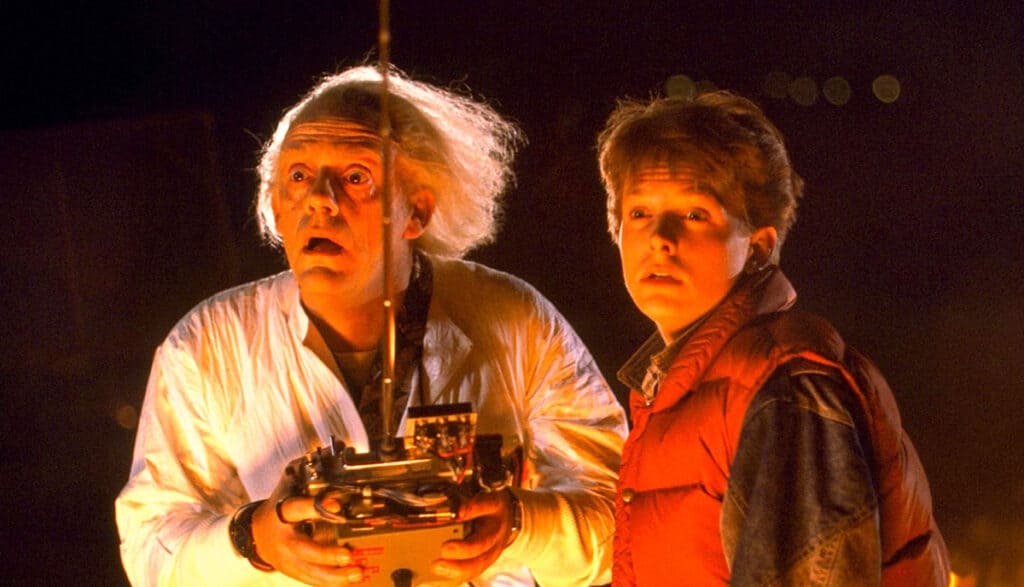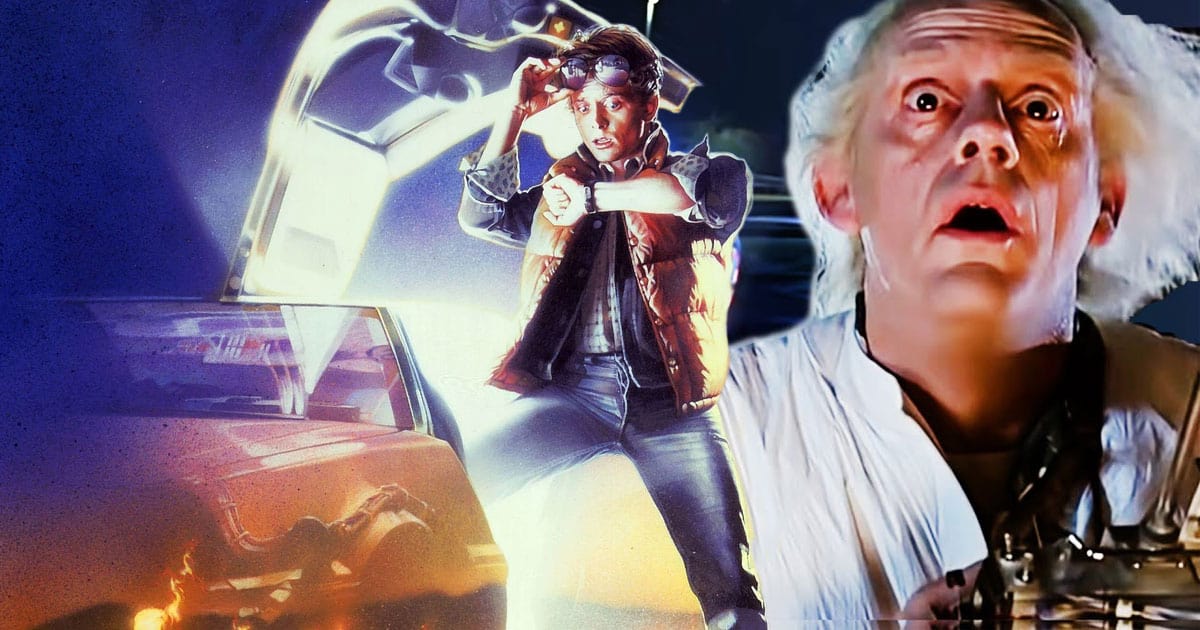
Last Updated on April 17, 2024
The year was 1985 when Super Mario Bros. took the Nintendo Entertainment System by storm; Bill Watterson’s Calvin and Hobbes debuted in newspapers, and two unlikely friends named Marty McFly and Emmett Lathrop Brown piloted cinema’s most iconic time machine to a year when Panama hats and kitten heels were all the rage, 1955.
Fiercely protected at a level akin to Ghostbusters and Star Wars by millennials worldwide, Robert Zemeckis’s Back to the Future sits enthroned at Nostalgia Mountain’s top. The original film has spawned two sequels, a cartoon series, video game adaptations, a Broadway musical, and more. But how does it hold up by today’s standards? Strap on your seatbelt, and prepare yourselves to see some serious shit because this is Back to the Future Revisited.
In 1977, Robert Zemeckis did the unthinkable. He bulldozed into Amblin Entertainment without an appointment, heading straight for Steven Spielberg’s office. Like a shower curtain ring salesman ready to dazzle potential customers with his wares, Zemeckis showed Spielberg his short film, A Field of Honor. Impressed with the presentation and seeing potential in Zemeckis’ work, Spielberg turned the up-and-coming filmmaker loose on the Beatles film I Want to Hold Your Hand as the project’s director and co-writer. Zemeckis tapped his friend and writing partner Bob Gale for the task, establishing a union that would become synonymous with excellence in the film industry.
While the film didn’t inspire Beatlemania’s levels of excitement from audiences, critics adored the comedic feature and recognized Zemeckis’ talent as a promising director. After establishing themselves as a dependable duo, Zemeckis and Gale partnered with Speilberg again for the war comedy 1941, featuring Saturday Night Live and SCTV alums Dan Aykroyd, John Belushi, and John Candy. Despite starring some of the funniest people in entertainment, 1941 went off like a dud grenade at the box office. Not to be discouraged, the Bobs, as people liked to call them, wrote another comedy with Spielberg executive producing called Used Cars. The film is about two competing car salespeople, with Kurt Russell, Jack Warden, and Gerrit Graham leading the cast. Regrettably, Used Cars was also a lemon for the team, making the Bobs oh for three at the box office.
While some filmmakers, after three failures, would consider their gooses cooked, Zemeckis and Gale continued to plug away at their ideas, determined to make a name for themselves in Hollywood. While Bob Gale was taking a breather, he visited his parents, where he stumbled upon his father’s old yearbooks. As he leafed through the tattered tome of academia’s past, he discovered his dad was president of his class. Surprised by the revelation, Gale’s wheels started turning as a question burned in his mind: Who was the president of my high school class, and would we have been friends?
Gale brought the idea to Zemeckis, and they started milling around with a story about a high school student who travels back in time and meets his parents. Rather than partner with Spielberg again, at the risk of earning a reputation for riding the filmmaker’s coattails, the Bobs went in a different direction. They took their idea to Frank Price, the president of Columbia Pictures. Price, known for taking risks on unconventional plots, loved what he heard and greenlit the project in seconds.
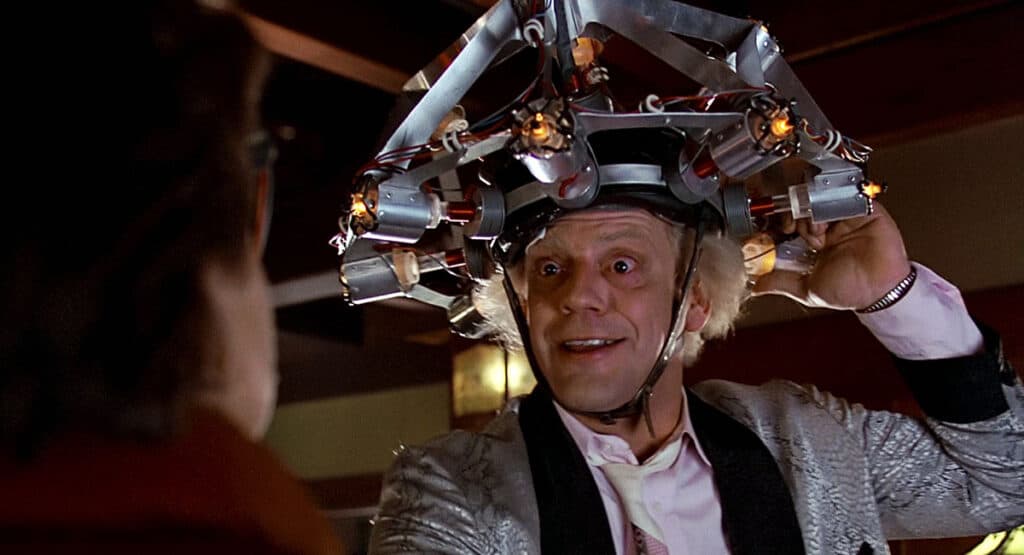
With Columbia Pictures eager to bring the Bobs aboard, the duo started writing the script for what would eventually become Back to the Future. Zemeckis and Gale returned in 1981 with their unconventional time-travel comedy, ready to turn back the clock, but time had become their enemy. Studios were scrambling to crack the code of general interest, and if there’s one constant they could depend on, it’s that the 80s was a horny time in American history.
Target audiences couldn’t stop thinking about sex, so comedies like Porkys, Loose Screws, Joysticks, Weird Science, Party Camp, and Revenge of the Nerds garnered more eyeballs than a science fiction comedy about returning to the prudish 1950s. Rather than scrap the concept, the Bobs revised their Back to the Future script to make Marty and Doc Brown’s time-traveling adventure more appealing, resulting in several iterations that never saw the light of day.
Aiming to buck tradition, Zemeckis and Gale set out to make a different time-travel movie. While other films treat the past as if written in stone, Zemeckis and Gale chose to explore the Butterfly Effect, meaning that even slight alterations could drastically change the future. In other words, if you travel back in time and prevent your parents from meeting one another, there’s a chance you won’t exist. The concept is a perfect narrative hook to explore the consequences of time travel, and the Bobs were determined to transform dire consequences into comedy.
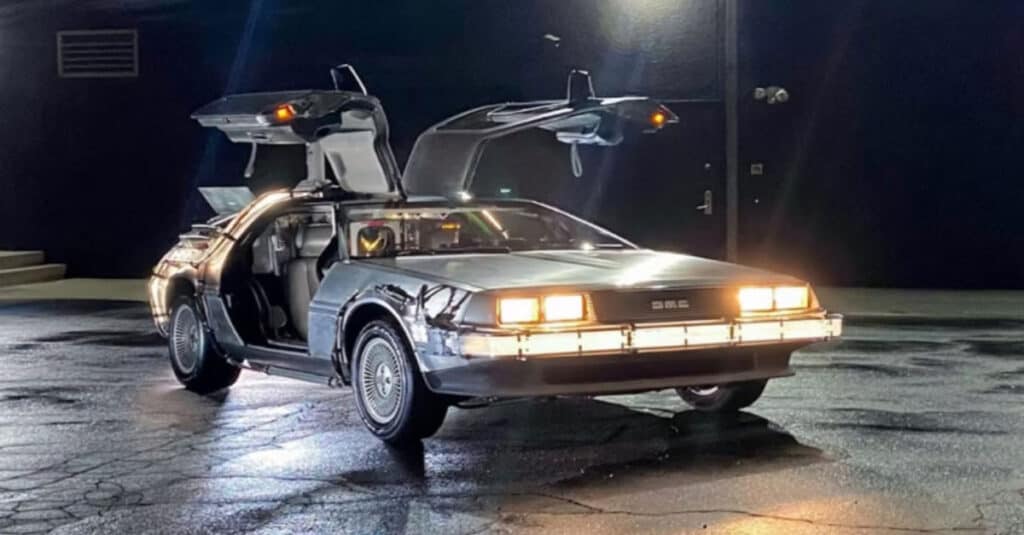
After taking a break from Back to the Future, Zemeckis directed the 1984 action-adventure film Romancing the Stone, starring Michael Douglas, Kathleen Turner, and Danny Devito. The film became a surprise success, giving Zemeckis the leverage he needed to return to Back to the Future. Since Price eventually passed on the project, Zemeckis brought his time-travel comedy to Steven Speilberg at Amblin Entertainment. Finally, with Gale and Neil Canton producing and Universal Pictures in charge of distribution, Back to the Future had a home, and the task of bringing the legendary pop culture classic to life could truly begin.
Racing into theaters at 88 miles per hour in 1985, Back to the Future is a movie that leaves an indelible mark on those who connect with it. I was four years old when I saw Back to the Future at the Rocky Point Drive-In Theater on the North Shore of Long Island, New York. Some will call foul, saying I can’t possibly recall a trip to the theater at such an early age. To them, I’d propose that some experiences are so monumental that even if they feel like a dream after so many years, they can reside in your memory forever.
United Artists owned the Rocky Point Drive-In, located slightly north of Route 25A in Rocky Point. Nestled in a dark, wooded area, the theater opened on June 16, 1961, with screenings of John Wayne’s The Alamo and the Robert Hinkle-directed Western Ole Rex. In 1985, theater security was lax. There were no security cameras, and audiences paid a flat fee for anyone they could fit in their car. Nearby speakers at each angled parking space provided audio for the film, and theater owners sold concessions at the back of the theater lot.
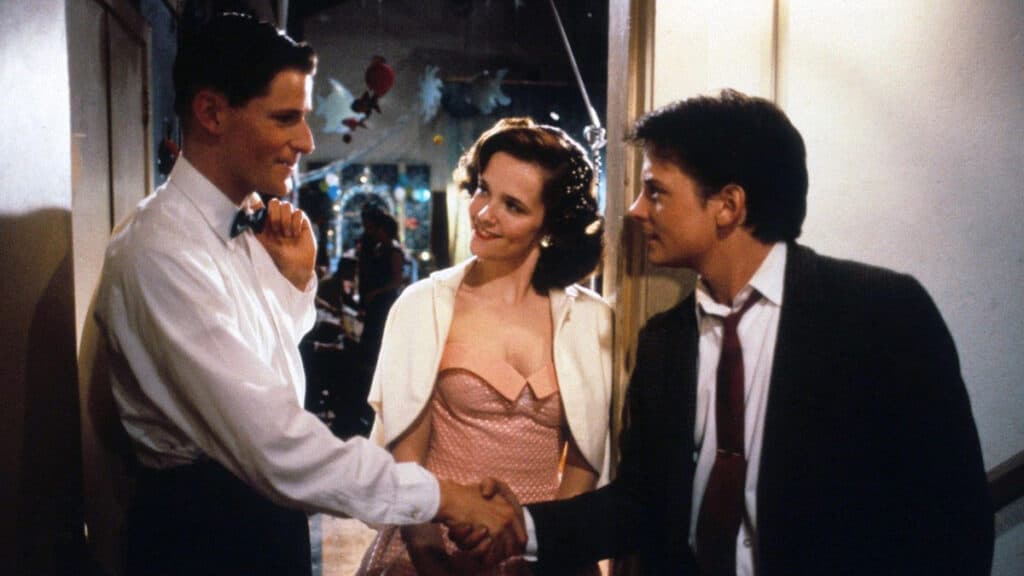
The night of our screening, my mom and dad threw my sister and me into the backseat of our 1983 powder blue Ford Station Wagon. Thankfully, Back to the Future was rated PG, so there was no need to hide beneath a blanket in what we called the “back-back” of the car. Lying like the dead beneath a comforter – often used to visit Cedar Beach in the hamlet of Mount Siani – was how my parents got my sister and me into R-rated movies at the drive-in back in the day. I’ll never forget when we saw Albert Magnoli’s Purple Rain starring Prince or John McTiernan’s Predator after successfully infiltrating the outdoor cinema beneath a blanket sprinkled with leftover grains of sand and random pieces of dried seaweed.
After some Coming Attractions and the 1957 version of “Let’s All Go to the Lobby,” the movie began to play just as the summer sun went to sleep. If there’s one thing I love most in life, it’s music, and for that reason, I distinctly remember the moment I connected with the film’s co-lead, Micheal J. Fox, and his iconic portrayal of Marty McFly. When Marty enters Doc Brown’s house during the film’s opening credits and hooks his Erlewine Chiquita guitar up to Doc’s complex speaker system, I knew Marty was the coolest movie character I’d seen at that point in my short existence. I imagined Marty as the teenage version of the guy in the 1981 Maxell commercial, paralyzed by a wave of relentless sound. If I had Doc’s setup today, I’d crank it to eleven and blast artists like Tool, Sleep Token, Failure, Dizzy, Bjork, Rachel Fannan, Rituals of Mine, HEALTH, and The Faint, to name a few.
Complimenting Fox’s performance throughout all three films in the Back to the Future trilogy is Christopher Lloyd as Doc Brown, a fast-talking man of science, unafraid to push the boundaries of reality to achieve the unthinkable. Llyod’s wily, frazzled, and hyper-intelligent Doc Brown brings an element of believability to the outrageous science on display. While I don’t think we can rupture the fictitious laws of time by combining a flux capacitor with a car going 88 miles per hour, Doc Brown makes us feel this impossibility is within his grasp.
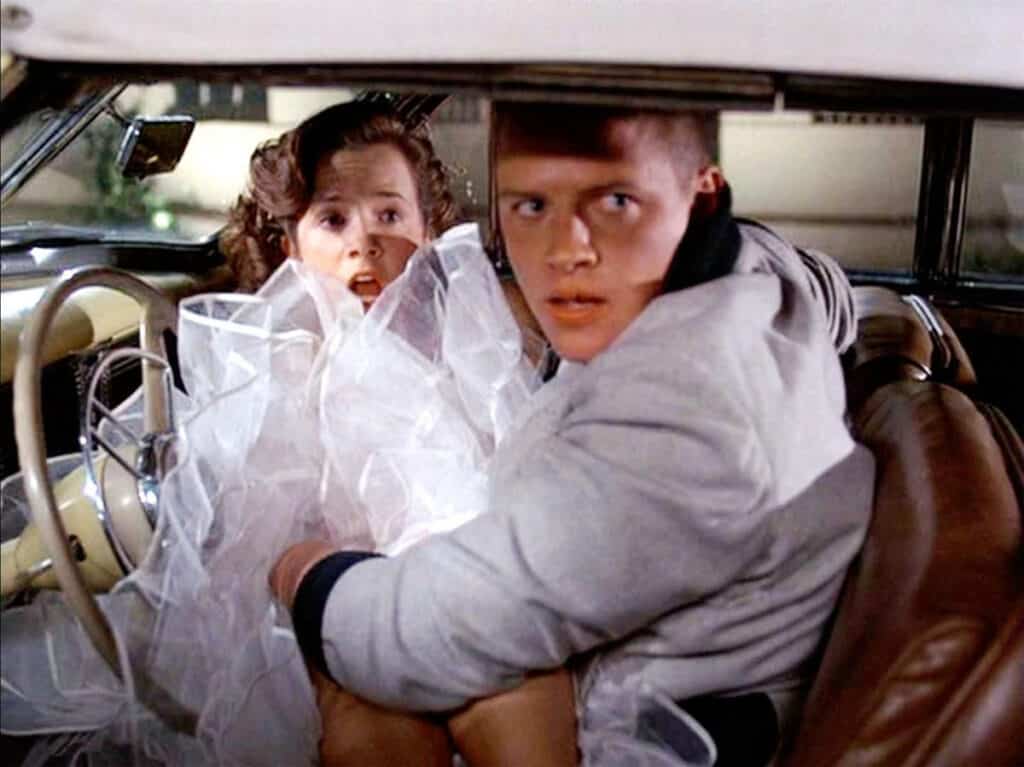
Marty and Doc’s on-screen chemistry is the stuff of cinema legend, whether they’re working alongside one another to ensure Marty’s existence after he inadvertently sabotages his parents’ courtship or changing future events to prevent a despicable bully from committing sexual assault. Fox and Lloyd are a dream team, making Eric Stoltz’s exit from the project a blessing in disguise. Stoltz almost played Marty in the film. However, his lack of comedic timing, distracting method acting approach, and desire to play Marty as a more tragic character eventually got him fired from the movie. As a result, portions of the film needed to be re-shot, with Fox bringing an entirely new energy to previously completed scenes.
Since we’re making this personal, I can’t think of Doc Brown without recalling my late friend, Harry Jackson, whom I met more than a decade ago on JoBlo’s Movie Fan Central message boards. Harry loved Back to the Future. So much so he even played Doc Brown in the 2019 commercial for Farpoint Toys & Collectibles, called “Collector’s Assemble.” After pulling up in an actual Deloreon, Harry’s Doc Brown leads an assembly of iconic characters to Farpoint in the promo. Much like Doc, Harry loved embracing the unknown and inspired smiles on those he met across time.
While I was too young for celebrity crushes during my first viewing of Back to the Future, Lea Thompson’s Lorraine Baines McFly made my gigawatts jump in later viewings. While Lorraine’s attraction to Marty is taboo, Gale and Zemeckis walk a delicate line throughout the film, keeping the creepiness of Lorraine’s uninformed lust to a playful minimum. Thompson’s performance is one of the film’s many highlights as she navigates a bizarre love triangle between herself, Fox’s Marty, and Crispin Glover’s George McFly.
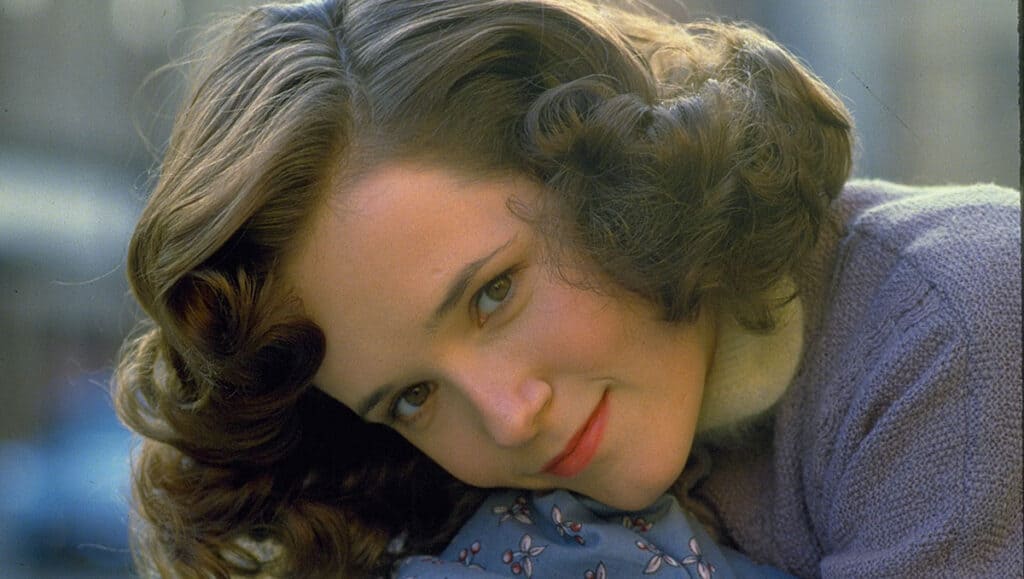
With a reputation for being difficult on set, Crispin Glover’s George McFly is one of the actor’s most memorable roles. Zemeckis wanted Glover to tone his performance down, but it’s perfect. Only some actors act awkwardly and strangely, like the spindly Crispin Glover. His transformation from a pervy “bird watcher” to a man worthy of being a secret character in Mike Tyson’s Punch-Out is a joy to watch, and I would not be surprised if some viewed George’s boost in confidence as something to aspire to.
Then there’s Thomas F. Wilson’s Biff Tannen, perhaps cinema’s most iconic bully. Wilson owns the role of Biff, with his intimidating stature, relentless acts of subjugation, and a motley crew of cackling henchmen. Biff is a villain Back to the Future fans love to hate, thanks to Wilson balancing Biff’s repugnance, skull-crushing noogies, and penchant for farm animal taunts.
Of course, a Back to the Future retrospective would only be complete with getting behind the wheel of the film’s true star, the DeLorean time machine. Developed under the watchful eye of Lawrence Paull, with design from artist Ron Cobb and illustrator Andrew Probert, the DeLorean is undoubtedly among the Top 3 time machines across cinema, alongside the Tardis from Doctor Who and Bill and Ted’s Telephone Booth. Growing up, the DeLoreon was the prized car in my Micro Machine collection. That car went everywhere with me and smoked any challenger in a high-speed race around my repurposed Hot Wheels race tracks.
Surprisingly, Doc and Marty’s time machine was a refrigerator early on, but Spielberg nixed the idea with concerns children might attempt to crawl into one. Could you imagine time-traveling refrigerators depicted on t-shirts, lunch boxes, and movie posters? Neither can I. Thank you, Mr. Spielberg—way to see the future with that miscalculation.
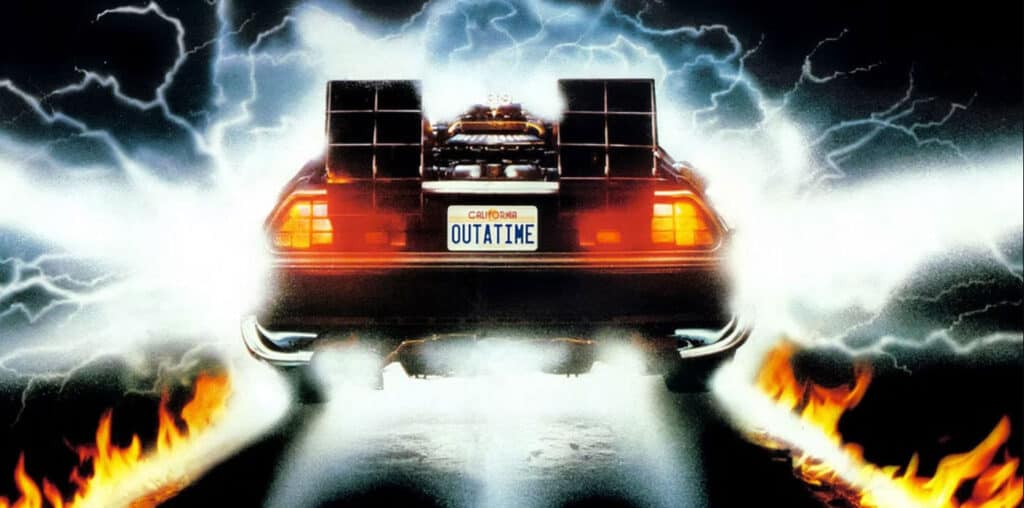
In the Nostalgia Museum of my mind, Back to the Future stands proudly alongside films like The Princess Bride, Labyrinth, Return to Oz, The Goonies, and whatever horror movie played on the living room television – my parents were seasoned horror enthusiasts. They never restricted me from watching movies like A Nightmare on Elm Street, Hellraiser, The Shining, and more. It was an interesting, nightmare-filled upbringing, I assure you.
Like its time-travelling premise, Back to the Future stands the test of time in more ways than one. Discussing popular science-fiction in cinema without waxing rhapsodic about Marty and Doc’s first escapade to the 1950s and back again is impossible. Hollywood keeps threatening to remake Back to the Future, but all attempts have failed for one reason or another. No one can replicate or even hope to match the look and feel of Zemeckis’s classic adventure. Back to the Future is a film that keeps giving back to multiple generations of fans, with memorabilia passed on or movie marathons arranged by obsessed parents.
It’s been a blast to revisit Back to the Future in 2024, knowing that a film released many years ago still leaves a lasting impression. Thanks for taking this trip in a DeLorean down Memory Lane. Now, if you don’t mind, I’m going to make like a tree and get out of here.
Originally published at https://www.joblo.com/back-to-the-future-revisited/

